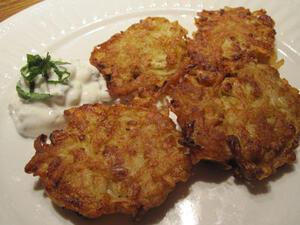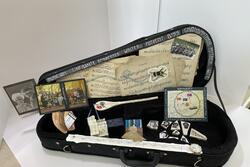Eating Jewish: Aloo Gobi Latkes
It’s that time of year again when food blogs and websites are filled with recipes for latkes and other fried delicacies for Hanukkah, and kitchens (along with the cooks!) begin to smell of all things deep fried. As my thoughts turned to the latkes I was going to make for Eating Jewish, I knew I wanted to do something different.
The inspiration for these latkes came after eating a delicious Indian meal, when the idea struck to take the ingredients of one of my favorite vegetarian curries and make latkes with them. The dish behind these latkes is called aloo gobi and is a curry made of potatoes (aloo) and cauliflower (gobi), mixed with onions and a multitude of spices. If you think about it, this dish consists of ingredients that translate perfectly into latkes and, if you ask me, were just calling to be transformed into crispy golden brown pancakes.
It may seem that latkes began to evolve after coming to North America, moving well beyond the traditional potato to being made with a variety of other vegetables and spices. However, upon reading the entry for latkes in Gil Marks’ Encyclopedia of Jewish Food it became clear that the latke has constantly been evolving, with the potato and onion latke we see as traditional being just one of its many incarnations.
Some of the first pancakes to be associated with Hanukkah were made with ricotta cheese and introduced to the Jews of northern Italy by Jews who were expelled from Sicily by the Spanish in 1492. On the other hand, soft cheese was a luxury item in northeastern Europe in the winter months, and because latkes were usually fried in schmaltz (rendered chicken fat), the use of dairy was out of the question. Therefore, latkes of that region were generally made using rye or buckwheat flour, or vegetables such as turnips. Later, the potato soon became the ingredient of choice with which to make latkes among the European Jewish community. An established part of Jewish food culture in North America, the latke's evolution continued with a variety of new styles emerging, such as zucchini, sweet potato, and corn, just to name a few.
When making these latkes, I took the ingredients that would be found in aloo gobi and re-worked them into this quintessential Hanukkah dish. I kept the base of traditional potato latkes by grating the potatoes and the onions, to which I then added small pieces of cauliflower and a mix of fragrant spices. Wanting to make these latkes gluten-free, I simply used an egg to bind them. (You could certainly add some matzo meal or flour, I found they held together perfectly fine without their addition.) The topping for these latkes is a yogurt dish that is a traditional accompaniment to spicy Indian curries called raita. It offers fresh, cooling flavors that complement the subtle spiciness of these latkes.
Taking a cue from one of my favorite Indian dishes was a great idea that made for deliciously different latkes. Do you have favorite variations on the potato latke? I would love for you to share them with me!
Aloo Gobi Latkes
Latkes:
2 cups large pieces of cauliflower
½ teaspoon turmeric
½ teaspoon ground coriander
½ teaspoon ground cumin
1 teaspoon garam masala
1/8 or ¼ teaspoon cayenne pepper
2 teaspoons salt
2 large potatoes, grated (I used Russet potatoes for this recipe)
1 medium onion, grated
1 large egg
Oil for frying (You can use vegetable oil or any other kind you prefer)
Raita:
1 cup plain greek yogurt
3 tablespoons mint, chopped using the chiffonade technique (layer the mint leaves, roll up tightly and cut across the rolled up leaves to create thin strips)
3 tablespoons cucumber, finely chopped
¼ teaspoon cumin
A pinch of cayenne pepper
Salt and pepper, to taste
-
In a small bowl, mix together the ingredients for the raita and refrigerate until you’re ready to use it.
-
Bring water to a boil in a medium pot; add the pieces of cauliflower and cook for 4 minutes, until just tender. Drain the water and place pieces back into the pot.
-
Using your fingers, break cauliflower into small florets, discarding the stems. Place the florets in a large bowl and set aside.
-
Heat 1 ½ tablespoons of oil in a small skillet. Add the spices and warm them until they become fragrant, 1 or 2 minutes. Add the spices to the cauliflower.
-
Grate potatoes and onion, place on a clean dishtowel or cheesecloth, and squeeze to remove excess liquid. Place the potato-onion mixture in the bowl with the cauliflower. Add the egg and mix to combine all ingredients.
-
Heat about ¼ cup of oil in a large skillet over medium high heat. Once the oil is hot, place heaping tablespoons of the batter into the skillet, using your spatula to flatten the mixture into rounds. Be sure not to crowd the skillet and only cook about 4 latkes at a time. When the edges are brown, flip the latkes and cook until the second side is golden brown. Transfer to a paper lined plate and repeat with remaining batter.
-
Serve latkes with the cucumber and mint raita.







